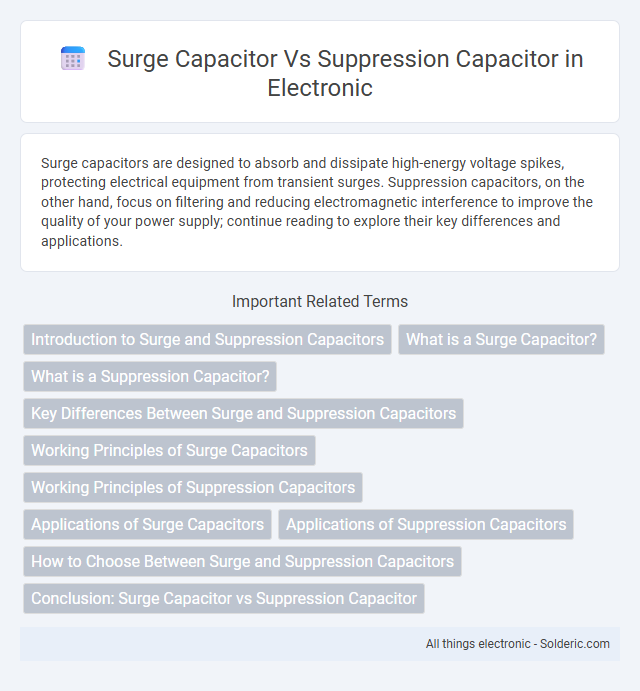Surge capacitors are designed to absorb and dissipate high-energy voltage spikes, protecting electrical equipment from transient surges. Suppression capacitors, on the other hand, focus on filtering and reducing electromagnetic interference to improve the quality of your power supply; continue reading to explore their key differences and applications.
Comparison Table
| Feature | Surge Capacitor | Suppression Capacitor |
|---|---|---|
| Primary Purpose | Absorb and control voltage surges | Suppress electromagnetic interference (EMI) and noise |
| Common Applications | Power systems, surge protection devices | Electronic circuits, noise filtering in power supplies |
| Capacitance Range | Typically higher capacitance values | Usually lower capacitance values |
| Voltage Rating | High voltage rating for absorbing surges | Moderate voltage rating, optimized for noise suppression |
| Construction | Robust design for high energy surges | Compact design focusing on high-frequency performance |
| Effect on Circuit | Protects equipment from transient overvoltages | Improves signal quality by reducing noise and EMI |
| Typical Materials | Metallized film, ceramic, or oil-impregnated types | Polyester film, ceramic, or multilayer ceramic capacitors (MLCC) |
Introduction to Surge and Suppression Capacitors
Surge capacitors are designed to absorb and manage high-voltage transients and spikes in electrical systems, protecting sensitive components from damage. Suppression capacitors, in contrast, focus on reducing electrical noise and electromagnetic interference (EMI) to ensure signal integrity and stable circuit operation. Your choice between these capacitors depends on whether transient voltage protection or noise reduction is the primary requirement.
What is a Surge Capacitor?
A surge capacitor is designed to absorb and mitigate high-voltage spikes caused by transient surges in electrical circuits, protecting sensitive equipment from damage. Unlike suppression capacitors, which filter or reduce electromagnetic interference (EMI) and radio-frequency interference (RFI), surge capacitors primarily handle sudden large voltage transients due to events like lightning strikes or switching operations. Understanding the role of a surge capacitor helps you select the right component for safeguarding your power systems against transient overvoltages.
What is a Suppression Capacitor?
A suppression capacitor is designed to filter and reduce high-frequency noise and voltage spikes in electrical circuits, protecting sensitive components from transient surges. Unlike surge capacitors, which primarily absorb large surge currents, suppression capacitors improve electromagnetic compatibility (EMC) by minimizing electrical interference. You rely on suppression capacitors in power supplies and signal lines to maintain stable and clean electrical performance.
Key Differences Between Surge and Suppression Capacitors
Surge capacitors are designed to handle high voltage spikes and transient surges, protecting sensitive equipment by absorbing sudden energy bursts. Suppression capacitors, on the other hand, filter out electromagnetic interference (EMI) and radio frequency interference (RFI) to prevent noise in electrical circuits. Your choice between surge and suppression capacitors depends on whether you need to manage transient overvoltages or reduce continuous electrical noise.
Working Principles of Surge Capacitors
Surge capacitors work by absorbing and dissipating sudden spikes of electrical energy in power systems, protecting equipment from transient overvoltages. These capacitors are designed to handle high-energy surges by temporarily storing the excess charge and releasing it safely, preventing damage to sensitive components. Understanding the working principles of surge capacitors helps you select the right device for efficient surge protection in electrical circuits.
Working Principles of Suppression Capacitors
Suppression capacitors work by absorbing and dissipating transient voltage spikes in electrical circuits to protect sensitive components from damage. These capacitors clamp voltage surges by providing a low-impedance path for high-frequency noise, thereby stabilizing your power supply and reducing electromagnetic interference (EMI). Compared to surge capacitors, suppression capacitors offer precise, high-frequency filtering capabilities essential for maintaining device performance and longevity.
Applications of Surge Capacitors
Surge capacitors are primarily used in high-voltage power systems to absorb and mitigate transient overvoltages caused by lightning strikes or switching operations, protecting sensitive equipment and enhancing system reliability. They are commonly installed in surge arresters, substations, and transmission lines to control voltage spikes and prevent insulation failure. Suppression capacitors, by contrast, are typically utilized in low-voltage circuits to reduce electrical noise and electromagnetic interference, improving the performance of electronic devices and communication systems.
Applications of Suppression Capacitors
Suppression capacitors are primarily used in electrical circuits to reduce electromagnetic interference (EMI) and voltage spikes, protecting sensitive equipment such as motors, transformers, and power supplies. They are commonly employed in power lines, motor drives, and industrial machinery to filter noise and enhance the reliability of your electrical system. These capacitors help maintain stable operation by suppressing transient voltage surges and minimizing signal distortion.
How to Choose Between Surge and Suppression Capacitors
Choosing between surge capacitors and suppression capacitors depends on the specific application and electrical protection requirements. Surge capacitors are designed to handle high-energy transient voltage spikes typically found in power distribution systems, providing voltage stabilization and energy absorption. Suppression capacitors, on the other hand, are optimized for reducing electromagnetic interference (EMI) and noise in electronic circuits, offering improved signal integrity and equipment longevity.
Conclusion: Surge Capacitor vs Suppression Capacitor
Surge capacitors are designed to absorb and dissipate high-voltage spikes, protecting electrical equipment from transient surges caused by lightning or switching operations. Suppression capacitors primarily focus on reducing electromagnetic interference (EMI) and voltage noise in circuits, enhancing signal integrity and performance. Choosing between surge and suppression capacitors depends on the specific protection or noise reduction requirements within an electrical system.
surge capacitor vs suppression capacitor Infographic

 solderic.com
solderic.com